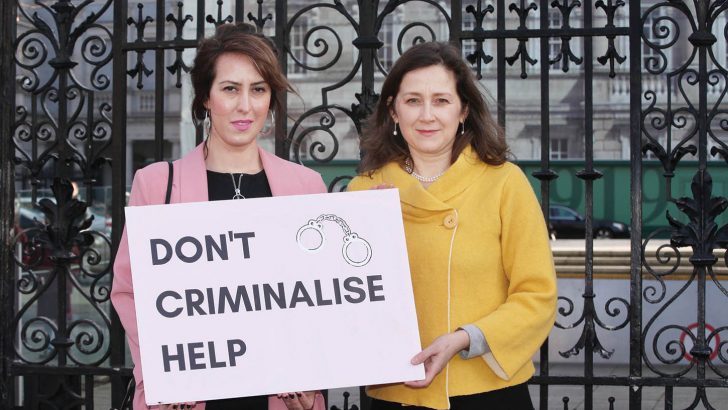The View
Since the abortion referendum passed, there has been a concerted effort by abortion proponents — including the Government — to restrict the freedom of expression of pro-life supporters. Peaceful prayer vigils outside hospitals are likened to violence and there are moves to ban them. Not content with this, it now seems that even the silent disapproval of those who detest the intentional killing of innocent human beings is too much for the fragile feelings of the abortionists.
Two weeks ago a study was published in the journal Contraception entitled ‘Exploring providers experience of stigma following the introduction of more liberal abortion care in the Republic of Ireland’. The thrust of the study is that abortion providers need to be protected from judgment and disapproval for their views and their actions. They should rather be validated by all.
The paper was authored by PhD psychology student Brendan Dempsey, Dr Aoife Mullally (clinical lead of abortion services in Ireland and sister of The Irish Times journalist, Una Mullally) and Drs Mary Higgins and Mary Favier (both pro-choice activists during the 2018 referendum campaign).
Stigma
The study was designed to examine whether abortion providers in Ireland experience stigma in relation to their jobs. This was measured using the Abortion Providers Stigma Scale – yes, apparently there is such a thing.
Out of 309 practitioners invited to participate, just over 50% (156) responded. The majority were GPs (67%) with obstetricians, midwives and nurses making up 31%. The vast majority of abortion providers were women (84%), with the largest cohort (42%) being in their 40s.
It found that Irish providers had fewer issues in disclosing their abortion work than their US counterparts. They also experienced fewer instances of judgment and discrimination, but higher levels of social isolation. The study, rather unhelpfully, does not define ‘social isolation’, or consider the possible effect of national lockdowns (the research was carried out between January and May 2020). The only hint of what might be involved is suggested in the following sentence: “Irish providers may experience stigma-related isolation if family and friends are opposed to the liberalisation of abortion care.”
GPs fare better, with doctors and nurses providing abortions in a hospital setting reporting higher levels of social isolation. The authors believe this may have something to do with the fact that obstetricians and midwives/nurses working in hospitals are generally involved in surgical and later-term abortions.
Instructive
The statistics are instructive here, and give us a picture of the reality of abortion in Ireland. Some 91% of abortions were carried out on babies under 12 weeks. According to the authors, a medical abortion (with the abortion pill) can take place until the baby is nine weeks and six days old. Between ten weeks and 11 weeks and six days, vacuum aspiration is available in ten hospitals around the country. This method of dismembering the baby was used in 25% of cases, either alone or in conjunction with the abortion pill.
The report states: “hospital staff may be attributed direct responsibility for ending the pregnancy and must encounter the foetal remains.” To put it bluntly, having to confront the physical reality of a dead baby’s body after having been aborted by vacuum tends to put people off, and leads them to hold the person who did the dismembering morally responsible. The report states that GPs don’t encounter this problem, as the end of the abortion happens at home – usually in a toilet – away from eyes that might have to encounter the evidence.
The report notes with concern that the procedure of Dilation and Evacuation (D&E), like vacuum aspiration, is also highly stigmatising, and though it is not yet on offer in Ireland, Irish doctors are currently abroad training in this method.
The authors record an astonishingly high rate of abortions on emergency grounds (44.2%), accounting for 69 out of the 156 providers who stated that they had carried out abortions on this particular legal ground. By contrast, for the year 2019, there were only three such cases in the whole country.
Despite the fact that in 2018 we were told to ‘trust doctors’, the authors come to the (logical) conclusion that many abortion providers are ‘reframing’ – or less euphemistically, lying about – the abortions they carried out as ‘emergency’ care. This is further highlighted by the fact that 37 of the providers were in the community (GPs or midwives), even though emergency procedures should only be carried out in hospitals, according to medical guidance. The authors surmise that providers may do this to avoid stigma, though they admit to no difference in levels of stigma reported between those providing emergency abortion and those who do not.
Referendum
There is, as we pointed out in advance of the referendum, another possibility: that doctors are using this ground to get around having to wait the three days before performing an abortion, or consulting with a colleague, or indeed to carry out an abortion after 12 weeks. The legislation under this ground sets no time limit, can be signed off and carried out by one doctor rather than two, and can be performed immediately.
In 2019, The Irish Times reported that approximately 2-3% of pregnancies involve a congenital abnormality, with only about 15% of that 2-3% being ‘life-limiting’.
And whereas in 2017, babies at risk of physical or mental abnormalities (a ground far wider than ‘fatal’ anomalies), accounted for just under 5% of all abortions carried out on Irish women in Britain, almost 22% of the abortions accounted for in this study were carried out under the ground of ‘Fatal Foetal Anomaly’. We know of at least one case – due to be heard by the High Court in June – where a wrong diagnosis was made, and a healthy baby aborted.
Providers
But to return to the issue of abortion providers experiencing stigma, the report states: “Our findings suggest that Irish providers, particularly those working in hospitals, may benefit from supports to reduce abortion-related isolation and challenges posed by collegial interactions or later-gestation care.” It also records medical practitioners experiencing “feelings of disapproval and disrespect from colleagues, as well as resistance and conflict”. By contrast, GPs work in much smaller practices and tend to provide care alone, shielding them from “stigmatizing interactions”.
The authors also surmise that hospital-based doctors and nurses may experience higher levels of stigma because they face protests outside hospitals. This is despite the fact that the gardaí, when asked, reported that there was no threatening or abusive behaviour by those involved in prolife vigils.
So the ‘stigma’ problem seems to arise in the following three circumstances:
1) friends and family don’t agree with the abortion providers’ actions;
2) abortion providers ‘feel’ that colleagues disapprove; and
3) unknown prolife protestors (who have no interaction with them) ‘make them feel’ stigmatised.
It is always surprising that a group convinced that it is morally right is so sensitive to even unspoken disapproval. Yet they never seem to consider that the problem might be with their moral certitude. No, the solution is clear: to compel friends, family, colleagues, and pro-lifers to celebrate and validate the abortion providers. It’s not enough that they enjoy a protected, secure, State job (and pension), which they are in no danger of losing, and that they are handsomely remunerated for their ‘services’. It’s not enough that – compared to their American counterparts – they experience far less judgment and discrimination, or that there is no danger of them being excluded from career progression. By contrast, an advert for a consultant post in Holles Street in 2019 made it clear that any doctor applying would have to be willing to cooperate with the abortion programme, thereby excluding Catholics and other prolife candidates.
Pro-life people are expected to put up with social isolation, rejection, threatening and abusive behaviour online and elsewhere, not to mention educational and career exclusion. We’re told that our freedom to hold our views means that we have to put up with these consequences, but it seems there’s a different rule for abortion providers. Their freedom to hold their views cancels out everyone else’s freedoms: even the freedom to disapprove. What is required, in the interest of freedom, is complete capitulation, leading to enforced uniformity, validation and celebration. Anything less might risk making an abortionist feel bad, and we can’t have that.


 Maria Steen
Maria Steen Pictured outside Leinster House at a 2019 protest against exclusion zones are Alina Dulgheriu from the London based group ‘Be Here for Me’ with Elizabeth Howard who has taken part in pro-life vigils outside the Ealing abortion clinic in London. Photo: John McElroy.
Pictured outside Leinster House at a 2019 protest against exclusion zones are Alina Dulgheriu from the London based group ‘Be Here for Me’ with Elizabeth Howard who has taken part in pro-life vigils outside the Ealing abortion clinic in London. Photo: John McElroy. 